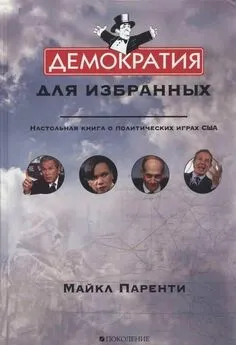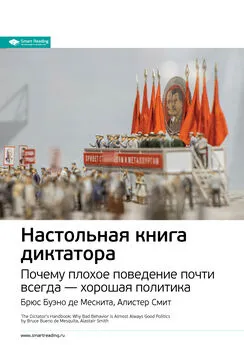Майкл Паренти - Демократия для избранных. Настольная книга о политических играх США
- Название:Демократия для избранных. Настольная книга о политических играх США
- Автор:
- Жанр:
- Издательство:Поколение
- Год:2006
- Город:Москва
- ISBN:5-9763-0016-2
- Рейтинг:
- Избранное:Добавить в избранное
-
Отзывы:
-
Ваша оценка:
Майкл Паренти - Демократия для избранных. Настольная книга о политических играх США краткое содержание
Принято считать, что США выдают себя за мировой оплот гражданских свобод, тем самым присваивая право «экспортировать» собственный тип демократии в другие страны. Что же представляет собой американская демократия на самом деле и можно ли вообще называть этот режим демократией?
Майкл Паренти — профессор политологии и гражданин США. В своей книге он дает нелицеприятную оценку господствующему в Америке политическому строю, который он метко характеризует как «демократию для избранных». Автор обличает лицемерие официальной идеологии США, выдающей власть привилегированного меньшинства за служение народу, и выдвигает американскому правительству впечатляющий список обвинений в нарушении прав человека. Его книга открывает для читателя совершенно другую Америку.
Демократия для избранных. Настольная книга о политических играх США - читать онлайн бесплатно полную версию (весь текст целиком)
Интервал:
Закладка:
New York Times, June 29, 1999, and June 20, 2000; San Francisco Chronicle, July 30, 1998, and May 25, 2000.
249
Бенефициарий — получатель средств по страховому полису, в случае медицинского страхования — врачи и лечебные учреждения. (Примеч. пер.)
250
L.J. Davis, «Medscam», Mother Jones, March/April 1995; New York Times,]u\y 17, August 8, and December 14, 1997; New York Times, November 4, 1999; исследование Управления генерального инспектора (Inspector General's Office) Министерства здравоохранения и социальных служб (Department of Health and Human Services), а также Управления общей бухгалтерской отчетности (General Accounting Office), reported in Los Angeles Times, July 28, 1997.
251
Eric Bates, «The Shame of Our Nursing Homes», Nation, March 29, 1999.
252
Phil Benjamin, «The Nations Health», People's Weekly World, February 26, 2000; «The Canadian Health Care System», Economic Notes, July /August 1991; Craig Whitney, «Medical Care in Germany», New York Times, January 23, 1993.
253
Michael Makover, Mismanaged Care: How Corporate Medicine Jeopardizes Your Health (Amherst, N.Y.: Prometheus, 1998); Charles Andrews, Profit Fever: The Drive to Corporatize Health Care and How to Stop It (Monroe, Maine: Common Courage, 1995); Ron Adler, «Why Your Doctor Isn't Happy to See You», San Francisco Chronicle, April, 7, 2000.
254
«HMOs to Drop 934,000 on Medicare», San Francisco Examiner, July 23, 2000; Laura McClure, «Just Healthcare», Labor Party Press, November 1998.
255
Lisa Davis, «Sutter's Giant Sucking Sound», San Francisco Weekly, January 21-27, 1998.
256
Ken Silverstein, «Millions for Viagra, Pennies for Diseases of the Poor», Nation, July 19, 1999; Don Sloan, «Profit and Loss in Medical Research», Peoples Weekly World, November 21,1998.
257
Baltimore Sun, October 19, 1996.
258
Joel Bleifuss, «Take a Powder», In These Times, March 3, 1997.
259
PDA Drug Review Disapproval Risk, General Accounting Office, Washington, D.C., May 1990; «Free-Market Medicine», Progressive, March 1992; New York Times, March 20, 1996, and April 15, 1998.
260
New York Times, February 21, 1994; Hilary Varner, «Milking the Public», Chicago Life Magazine, October 1995.
261
The Use of Drugs in Food Animals: Benefits and Risks, National Research Council, 1998; Margaret Mellon, «Prescription for Trouble», Nucleus, Winter 1998-99; «FACT Calls for End to Farm Drug Abuse», годовой отчет Food Animal Concerns Trust, Chicago, Winter 1999; Humane Society statement: New York Times, February 27, 1998.
262
См.: ; а также ; см. также Joseph Kinney et al, Ending Legalized Workplace Homicide (Chicago: National Safe Workplace Institute, 1988); and Race and the Risk of Fatal Injury at Work, исследование, проведенное Department of Epidemiology, University of North Carolina, 1998.
263
Christopher Cook, «Losing Life and Limb on the Job», Progressive, February 2000.
264
Jonathan Kozol, Savage Inequalities (New York: Crown, 1991); Neil Christopher, «Property Taxes Fund Education Inequity», Peoples Weekly World, July 1, 2000.
265
New York Times, July 27, 2000.
266
«Cost of College Shutting Students Out», San Francisco Chronicle, November 18, 1998.
267
«Naked Cities», Nation, January 6, 1997.
268
Los Angeles Times, April 18, 1992.
269
Christopher Jencks, «Half-Right on Public Housing», New York Times, May 20, 1997.
270
Раздел 8 — Государственная программа аренды или приобретения жилья за ваучеры. Ее название происходит от раздела 8 закона США «О развитии жилищного строительства» (Section 8 of the U.S. Housing Act, 1937). Это крупнейшая федеральная программа помощи в приобретении жилья для людей с низкими доходами. (Примеч. пер.)
271
Michael Winerip, «Doors Shut to Poor Seeking Homes», New York Times, July 22, 1996; Study by Center on Budget and Policy Priorities, reported in New York Times, April 22, 1996.
272
U.S. House of Representatives task force report in Washington Post, December 26, 1987; Joel Blau, The Visible Poor, Homelessness in the United States (New York: Oxford University Press, 1992).
273
См. ежегодный отчет о положении бездомных Национального правового центра по бездомности и бедности (National Law Center on Homelessness and Poverty, Washington, D.C.) и Becky Johnson and Robert Norse, «Mean Sweeps», Street Spirit (Bay Area, Calif.), June 1997.
274
Jane Holtz Kay, Asphalt Nation: How the Automobile Took over America, and How We Can Take It Back (New York: Crown, 1997).
275
Washington Post, September 3, 1989; Kay, Asphalt Nation.
276
В отношении недавних примеров промышленного загрязнения см. New York Times, March 16,1997; Associated Press report, January 25,1999; DUuth News-Tribune, May 2,1999; Pratap Chatterjee, «Who Is Stealing Our Future», CovertAction Quarterly, Fall 1996; Lois Marie Gibbs and Citizens Clearing House for Hazardous Waste, Dying from Dioxin (Boston: South End, 1995).
277
«Brazil of the North», Briarpatch (Saskatchewan, Canada), July/August 1997.
278
«Cutting the Heart Out of the Ancient Redwoods», Greenpeace Quarterly, Spring 1997.
279
San Francisco Chronicle, October 26, 1998.
280
Michael Brower and Leon Warren, The Consumer's Guide to Effective Environmental Choices (New York: Three Rivers, 1999).
281
Theodore Colborn, Dianne Dumanoski, and John Peterson Meyers, Our Stolen Future (New York: Dutton, 1996); Ron Nixon, «Toxic Gumbo», Southern Exposure, Summer/ Fall 1998; New York Times, July 17, 1995; Ulla Lehtinen, «Nuclear Waste and Native Land», Oregon PeaceWorker, September 1998; San Francisco Examiner, March 23, 1998.
282
Согласно исследованию Natural Resources Defense Council, Environmental Working Group, and Environmental Information Center (Совета по охране национальных ресурсов, Рабочей группы по окружающей среде и Информационного центра по окружающей среде), May 9, 1996.
283
Nucleus, Union of Concerned Scientists, Spring 1998; Greenpeace Magazine, Fall 1997; Marian Hetherly, «Worth Noting», Humanist, March/April 2000.
284
Sandra Steingraber, Living Downstream: An Ecologist Looks at Cancer and the Environment (Reading, Mass.: Addison-Wesley, 1997).
285
В отношении пестицидов и связанных с ними проблемах здоровья см. Our Children at Risk (Washington, D.C.: Natural Resources Defense Council, 1997); reports by Consumers' Union: ; studies by Environmental Working Group, Washington D.C.: http://www.ewg.org/pesticides и Environmental Health Perspectives, March 1999 и журнал Bioscience, November 1992.
286
Robert Van Den Bosch, The Pesticide Conspiracy (Garden City, N.Y: Doubleday, 1978).
287
Цитата из выступления Дж. Буша приводится по Los Angeles Times, February 6, 1990; см. также Jed Greer and Kenny Bruno, Greenwash: The Reality behind Corporate Environmentalism (New York: Apex, 1997) и Endangered Education: How Corporate Polluters An Attacking Environmental Education (Oakland, Calif.: Center for Commercial Free Public Education, 1997).
288
Eban Goodstein, «Does Preserving Earth Threaten Jobs?» Dollars and Sense, May 1997.
289
Lester Brown, «Natural Limits», New York Times, July 24, 1993; Zero Population Growth newsletter, Washington, D.C., June 1993.
290
Ross Gelbspan, «Putting the Globe at Risk», Nation, November 30, 1998; Nucleus (publication of Union of Concerned Scientists), Summer 1997; David Corn, «White House vs. Greenhouse», Nation, October 13, 1997.
291
Los Angeles Times, January 9,1998; Greenpeace newsletter, July 2000; San Francisco Chronicle, March 11, 2000.
292
New York Times, November 3, 1997.
293
Ross Gelbspan, The Heat Is On: The Climate Crisis, the Cover-Up and the Prescription (Reading, Mass.: Perseus, 1998); Washington Post, June 12, 2000.
294
Robert Gould, «The Greenhouse Effect on Health», San Francisco Examiner, October 27, 1997.
295
Christian Parenti, «NASA's Assault on the Ozone Layer», Lies of Our Times, September 1993. For updates on the ozone, see .
296
Richard McKenzie et al., «Increased Summertime UV Radiation in New Zealand in Response to Ozone Loss», Science, September 10, 1999; Janet Wagner, «Double Exposure», Nucleus, Winter 1995-96.
297
В отношении этих нескольких примеров см. San Francisco Examiner, May 15, 1997; Los Angeles Times, August 3, 1996; and New York Times, October 10, 1997.
298
Chellis Glendinning, «Cell-Phone Towers' Effects Under Wraps», Santa Fe New Mexican, April 15, 2000.
299
Three-mile-island — островок на реке Саскуэханна близ города Харрисберга (штат Пенсильвания), на котором расположена атомная электростанция. В 1979 году произошла первая в истории ядерной энергетики крупная авария на АЭС. В результате аварии произошел выброс радиоактивных материалов в атмосферу, что повлекло за собой эвакуацию тысяч жителей близлежащих районов. (Примеч. пер.)
300
Karl Grossman, «Three Mile Island: They Say Nothing Happened», Extra!, July/
Читать дальшеИнтервал:
Закладка:








